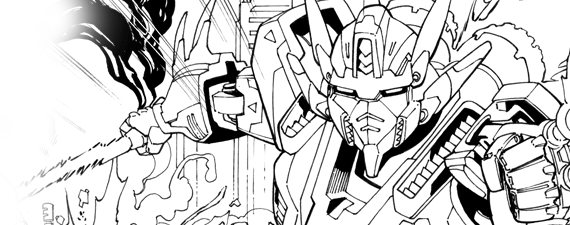
Halloween horror with Source Point Press and Comics Experience continues with the October 30 release of Wild Strawberries at the World’s End! Written by Bruce Kim and with art by Katia Vecchio, the suspenseful story takes place in a rural South Korean town during the mid-’90s. There’s murder. There’s cults. There’s mystery. There’s the supernatural. It’s a perfect autumnal read when you want to enjoy a hot drink and a tingle up the spine.
But why don’t we let Bruce tell you more about it in his own words?
Comics Experience: How did you come up with and develop Wild Strawberries at the World’s End?
Bruce Kim: I grew up in Korea until I moved to New York for college. I visited my hometown in Korea again when I turned 30. What really struck me was how familiar and foreign at the same time it felt. The streets and blocks that I have vivid memories of were populated with unfamiliar faces and new stores. In Ingmar Bergman’s Wild Strawberries (an obvious inspiration for the title) the main character Isak, an old professor, visits his childhood home and sees his past memories coming alive in front of his eyes. That’s how I felt during my trip.
I wanted to write a story that captured and process what I felt at that time: the sense of longing and anxiety you feel as you enter adulthood. I wanted to write a story that was specifically Korean. In Wild Strawberries at the World’s End, the main character (Te-Su) comes back to his hometown for a friend’s funeral. While investigating his friend’s death, Te-Su confronts his regrets, nostalgia, and anxiety. The book explores these themes with the prism of a Lovecraftian mystery. I think the regrets you have as you get older can feel Lovecraftian.
Many of the plot points were taken from my personal experience. Korea was in a transitional period in the ’90s. We still had shanty houses all over the cities right next to new high-rise apartments. I grew up with friends who lived in makeshift houses, and those shanty towns all disappeared at some point. Now there are nice parks and malls on those spots. I’ve always wondered where all the people who lived in those towns went. And this became the inspiration for one of the central mysteries of the book.
CE: What is your process like with Kate?
BK: Before we started working on the project, we had research sessions. The book is set in rural Korea and capturing that local texture was crucial. Katia is an Italian artist, so bridging the cultural gap was important. South Korean new wave thrillers were key influences for the book, so I recommended 4~5 Korean movies to Katia. The most important one was Bong Joon Ho’s Memories of Murder (a serial killer film set in 80’s rural Korea) which we directly reference in one of the panels. In addition, I’ve created a detailed visual reference guide. In addition to being an extremely talented and versatile artist, Katia was interested in Korean culture and captured the texture of ’90s rural Korea perfectly.
My script (you can find it in the Comics Experience database) is much more detailed in its visual directions than standard comic book scripts. I often had specific ideas about panel layout, scene composition, and color palette. I knew how good Katia was as a visual storyteller, and I wanted to lean on that strength as much as possible. In comics, every text on a page needs to justify its existence. Either the text conveys information you absolutely cannot convey with visuals only or the prose has to be very memorable. (There are times when you need text to control the time a reader spends on a page, but this wasn’t an important consideration for our book) I was specific in my visual ideas to provide a jumping-off point to Katia. I wanted my script to start a discussion rather than stifle Katia’s creativity. I continued to cut down on texts as I got the sketches from Katia. I’ve also used Ales Kot and Morgan Jeske’s Change to size how many texts can fit for a given panel size – I almost used that book as a ruler. Change is a good book to use as a reference as it experiments with various panel layouts.
Grant Morrison once said that every issue of comic book needs one sequence that the reader has never seen before. And it’s something that I always think about. I think every book needs a formally inventive sequence that punctuates the story. For us, the key sequence is the wordless 12-panel grid + page-turn reveal sequence. In the sequence, lightening intermittently illuminating a pitch-black room reveals a stranger slowly approaching. Building suspense with a grid structure layout is not easy, and we went through multiple iterations to get it right. Katia’s subtle command of timing and facial expressions made this sequence possible. It is still the section that I’m most proud of.
CE: How did your involvement with the Creators Workshop and Comics Experience shape Wild Strawberries at the World’s End?
BK: I’ve posted my scripts in the creator’s workshop forum, and the feedback I got was critical in shaping the story. The members who’ve helped me out will notice that the key plot twist is different in the final book. I want to be a little cautious here not to spoil the story, but the feedback from the members made me realize that the initial twist was overcomplicating the story and undercut the theme of the story. It was very unwieldy on hindsight.
More importantly, many of the feedback had very thoughtful reflection on what the theme of the story was. At times, this made me realize subtexts that I didn’t realize I had. And it also crystalized what ideas weren’t working. This opportunity to self-reflect helped me streamline what ideas I wanted to explore more.
I think many members will notice that the second half of the book is quite different from the initial script. I’ve reread my 1st draft recently, and I was cringing the whole time. I believe that every Comics Experience member who gave feedbacks on the script are editors and collaborative partners of Wild Strawberries at the Word’s End.
Remember to pick up your copy of Wild Strawberries at the World’s End on October 30!

